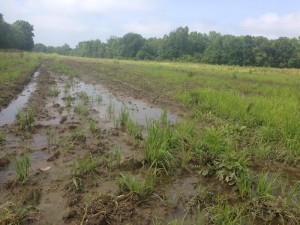Blog
The Reign of Rain

Can you remember a wetter summer? We’re scratching our heads and hoping the bird will
return with the olive branch soon! Of course, farmers are never happy with the weather, but this has to be one for the record books. I have searched the internet to get confirmation of the totals, but around here the
neighbors are saying we got right at 14 inches of rain in the last three weeks. Paint Lick Creek slices through our farm in a couple of places and is typically a friendly little stream that quietly makes its way to the Kentucky River. This summer it has been transformed into raging waves of water spilling out of its modest boundaries.
What about our vegetable crops? What happens when they get too much water? Well, as you can imagine, they are at increased risk for disease and nutrient deficits caused by the overabundance of moisture in the soil. Getting into the fields to cultivate is almost impossible in some places because of the standing water. One plant that grows really well in these conditions is the invasive week Johnson grass. Our lunchtime discussion today centered around ways to address the soil conditions that are allowing this weed to grow so profusely in certain areas of the farm.

During times of extreme weather challenges, we are acutely aware of the CSA[quote cite=’Steven McFadden’ align=’right’]CSA’s are “constellations of local farms, food and people who are united in an agrarian relationship for the health of people and planet.”[/quote] members’ support and the connection we share to the health of our farm. In the Rodale Institute’s recently released post “CSA’s and Aggregators, Threshing Things Out”, writer Steven McFadden describes CSAs as “constellations of local farms, food and people who are unitedin an agrarian relationship for the health of people and planet.” The potential and direct impact that the weather can have on our harvest and what ends up in your kitchen as CSA members demonstrates our connectedness in ways that typical food buying does not do.
To quote the post:
“What interested people in CSA at the start nearly 30 years ago was a fundamental recognition that our relationship with nature and the ways that we use the land will determine the future of the earth. Thus, ultimately the problems of agriculture and the environment belong not just to farmers, but to all people. In the end, no one can escape responsibility for the well-being of the earth. CSA was intended to provide a direct pathway for every person and every household to participate actively through a web of relationships with each other, farmers and farms.”


